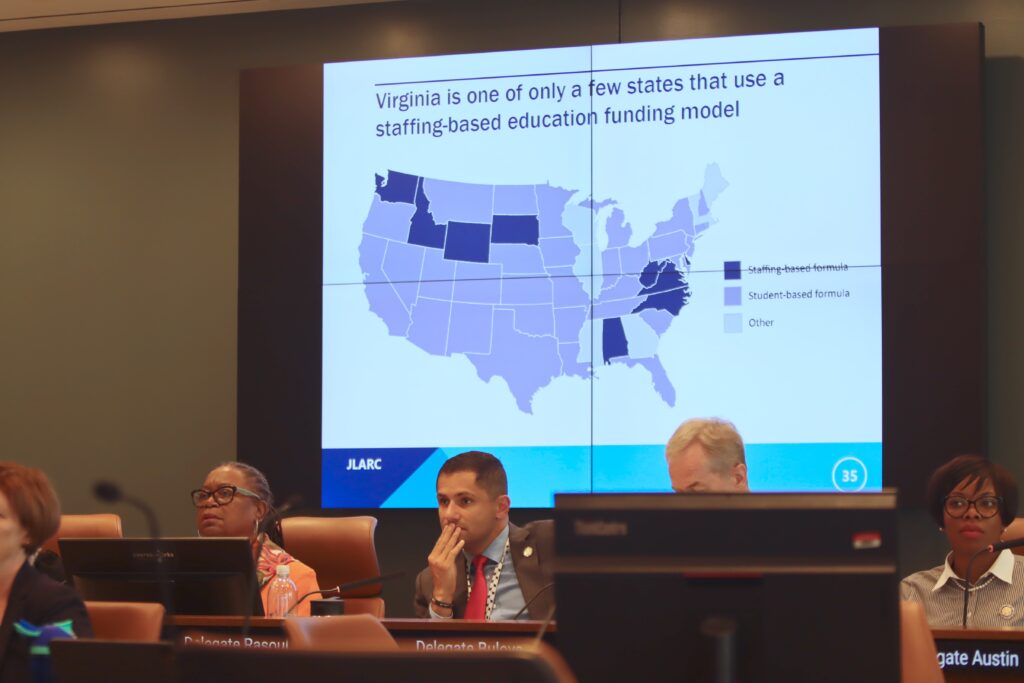
Virginia lawmakers follow a presentation about the state’s funding formula for education during a Sept. 16 meeting in Richmond. (Nathaniel Cline/Virginia Mercury)
On Thursday, Virginia lawmakers discussed ways to address the state’s decades-old funding formula, which determines the funding level for public schools, and considered a series of near-term recommendations that could be phased into the commonwealth’s plans within three to four years.
Lifting the support cap, which limited the number of support positions the state would fund, was one of the recommendations put forth by Joint Legislative Audit and Review Commission researchers. JLARC’s December study showed that local governments in Virginia are spending more to pay for K-12 education than the commonwealth to fund the state’s Standards of Quality in Virginia school divisions.
Virginia’s SOQ formula determines funding for divisions by calculating the number of staff they need and then the cost of those staff.
Other near-term recommendations from JLARC:
- Address technical issues with the formula
- Discontinue Great Recession-era cost reduction measures such as the support cap
- Use division averages instead of approximating what most school divisions spend on operating their schools in calculations.
The commission also recommended that the Local Composite Index, or a locality’s ability to pay education costs, should be changed to a three-year average instead of every two. They also suggested changing the at-risk funding formula that would impact low-income or students identified as “at-risk,” and studying special education staffing needs.
The joint subcommittee, tasked with reviewing and proposing changes to the funding formula, learned that on Thursday, the near-term recommendations could be phased in over three to four years. The long-term recommendations are “more complex and will require additional review to implement,” the commission told them.
Terry Jones, a special education teacher and member of the Virginia Education Association, said at Thursday’s joint subcommittee hearing with members of both the House and Senate that since the pandemic in 2020 and the continued exodus of k-12 teachers, special education has been one of the hardest hit areas in terms of staffing.
“(It’s been) so severe that classrooms are often led by substitutes or adults with no training in education and in many schools, this is more than half of the classrooms,” said Jones.
He said while lawmakers are considering long-term reforms, including shifting to a student-weighted funding model compared to the current staff-based model, “they don’t address the immediate needs we face today,” urging them to act immediately.
Some of the long-term recommendations offered by JLARC:
- Develop and adopt new staffing ratios similar to more accurately reflect how divisions are staffed
- Update old salary assumptions during rebenchmarking, a period every two years in which the state reviews the cost of continuing to provide direct aid to programs
- Replace the cost of competing, a measure to help school divisions compete for staff in more expensive labor markets, with a new and more accurate method
- Add economies of scale adjustment, or a cost savings measure, to provide additional funding to divisions with fewer than 2,000 students.
Understanding the support cap
According to staff, the committee received responses about the funding formula from nearly 60 respondents, who were not identified to the public. Staff said some of the responses expressed support for lifting the support cap.
The cap was enacted during the Great Recession in 2007, impacting central office and administrative, technical, clerical, maintenance and instructional support positions.
Funding levels have never been fully restored, but the support cap was partially lifted last year, which increased the funding ratio from 21 support positions per 1,000 pupils to 24 per 1,000 pupils.
Del. Terry Austin, R-Botetourt, said he hopes the committee will work with the Virginia Department of Education to ensure the funding supports classrooms.
“I know the support cap is very broad and what it covers, but I hope our emphasis will be on improving the quality of education and putting the dollars where we’ll get the most benefit from them,” Austin said.
The legislature allocated $600,000 to the department over the next two years to support the subcommittee.
In terms of studying special education staffing needs, JLARC identified that per-pupil special education funding has declined over the last 10 years when adjusted for inflation.
Researchers also found that the most significant gap between SOQ formula estimates for staffing compared to actual division staffing was in instructional aides, including special education.
In the last session, Gov. Glenn Youngkin vetoed legislation that would have reviewed special education staffing needs in an omnibus package he and Democrats sparred over regarding teacher pay.
However, some of the legislation’s elements were successfully passed in the 2024-2026 budget.
Lawmakers agreed to allocate $72.1 million over the next two years to expand and provide targeted support for English learner students and $371.3 million in additional funding for at-risk students over the next two school years.
The legislature also redirected approximately $650 million each year and added around $180 million yearly to develop the at-risk program. Most localities have opted into the program, which helps to provide sufficient funding for schools to serve low-income students in Virginia.
“We’ve done quite a bit in the areas of ELL and at-risk, but this is one of the areas that we have neglected,” said Sen. Mamie Locke, D-Hampton, adding that there may be some overlap with ELL and at-risk, “but I think that this is one area where we do need to do some work.”
The committee will next meet on Dec. 9 ahead of the 2025 General Assembly session that starts in January.
GET THE MORNING HEADLINES.

